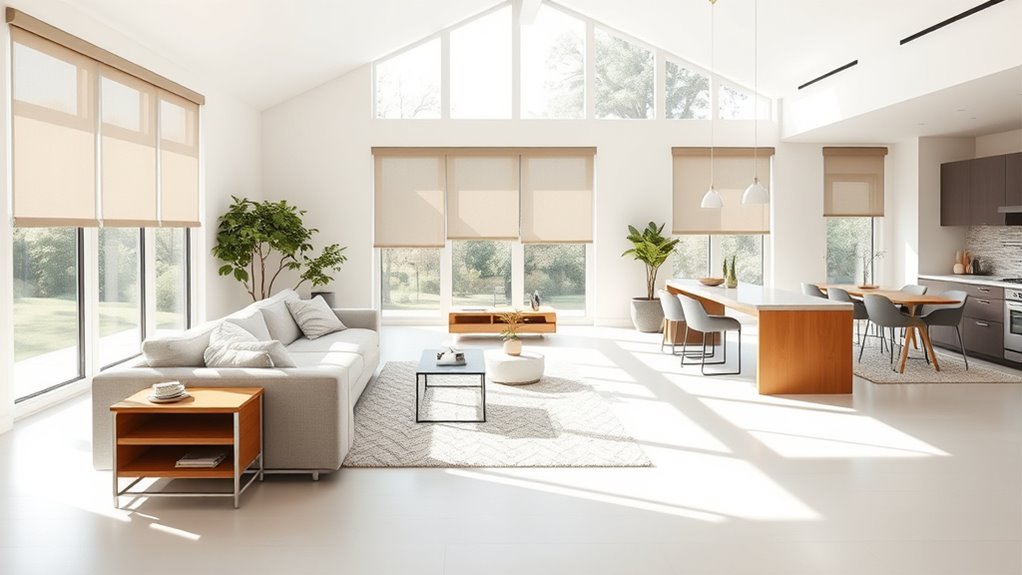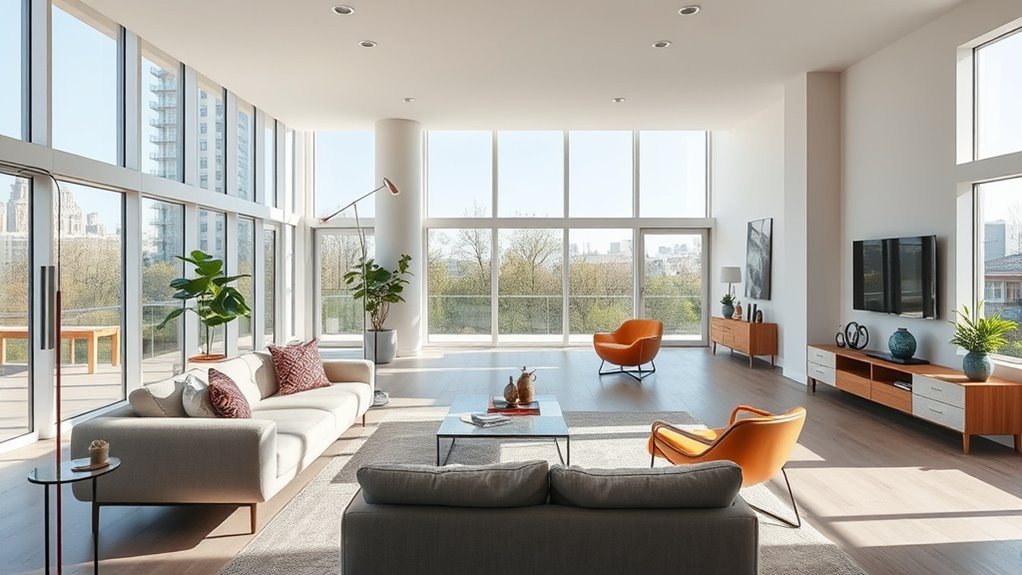The art of universal design helps you create a stylish, adaptable home that meets your current needs and adjusts smoothly for the future. Incorporate smart technologies, flexible layouts, and inclusive aesthetics to make your space both functional and beautiful. Use practical features like wide doorways and lever handles that support everyone, now and later. By prioritizing thoughtful design and financial planning, you guarantee your home remains comfortable and secure as your needs evolve—discover how to master this approach further.
Key Takeaways
- Incorporate adaptable technologies like voice controls and smart lighting to customize and future-proof your living space.
- Use inclusive design principles that blend aesthetics with accessibility, ensuring spaces remain visually appealing and functional.
- Plan open layouts with flexible features such as lever handles and modular elements for long-term adaptability.
- Prioritize harmonious design that reflects personal style while supporting diverse needs and enhancing comfort.
- Combine thoughtful home modifications with strategic financial planning, like secure retirement options, for comprehensive future security.

Have you ever wondered how environments can be accessible and functional for everyone? It’s a question that lies at the heart of universal design, which aims to create spaces that serve all users, regardless of age, ability, or circumstance. One of the key ways you can achieve this is by integrating adaptive technologies into your home. These innovations, such as smart lighting, voice-activated controls, and adjustable countertops, make daily living easier and more intuitive. Adaptive technologies are flexible tools that respond to your needs, allowing you to customize your environment effortlessly. When you incorporate these into your home, you’re not just making it more accessible — you’re future-proofing it, ensuring it remains functional as your needs evolve over time.
Integrate adaptive technologies to make your home more accessible, functional, and future-proof for evolving needs.
But accessibility isn’t solely about tools and gadgets; it also involves aesthetics. Inclusive aesthetics blend form and function seamlessly, ensuring that your home looks appealing while remaining practical. Instead of sacrificing style for accessibility, you can choose design elements that are visually pleasing and inclusive. Wide doorways, for example, can feature elegant archways or modern frames that complement your overall decor. Leveraging inclusive aesthetics means focusing on harmony and balance, creating spaces that feel welcoming and sophisticated while accommodating diverse needs. When your home’s design is thoughtfully crafted, it reflects your personal style while supporting an inclusive environment.
Thinking ahead means considering how your home can adapt as circumstances change. Universal design emphasizes simplicity and flexibility, which can be achieved through thoughtful planning. For example, open floor plans not only foster social interaction but also allow for easier navigation and mobility. Installing lever handles instead of traditional knobs can make doors easier to open for everyone. These small yet impactful choices demonstrate how adaptive technologies and inclusive aesthetics work together to create spaces that are both beautiful and functional. By doing so, you ensure your home remains comfortable, accessible, and stylish for years to come, regardless of any future physical or technological changes.
Additionally, understanding the importance of Gold IRA options can be a strategic way to secure your financial future, complementing your efforts to create a resilient and adaptable living space. Ultimately, universal design isn’t just a trend — it’s a philosophy that values inclusivity and foresight. When you prioritize adaptable technologies and inclusive aesthetics, you create a living space that welcomes everyone and adapts seamlessly to your evolving needs. It’s about making your home a place where comfort, style, and accessibility coexist effortlessly. By embracing these principles now, you’re not only enhancing your daily life but also investing in a future where your home remains a true sanctuary for you and everyone who enters it.
Frequently Asked Questions
How Does Universal Design Impact Home Resale Value?
Universal design can considerably boost your home’s resale benefits by making it more accessible and appealing to a broader market. When you incorporate features like wider doorways, no-step entry, and adjustable countertops, you enhance your property’s market appeal. These improvements attract buyers looking for future-proof homes, increasing the likelihood of a quicker sale and potentially higher offers. Overall, universal design adds lasting value and versatility to your home, benefiting you in the long run.
Are Universal Design Features Cost-Effective Long-Term Investments?
While some see universal design features as an investment, they’re actually a smart choice for your long-term planning. A careful cost analysis and attention to maintenance considerations reveal these features often save money over time. You’ll benefit from greater accessibility and flexibility, making your home adaptable for changing needs. In the end, investing in universal design can be both financially wise and personally rewarding, ensuring your home remains comfortable and functional.
Can Universal Design Be Customized for Aesthetic Preferences?
Yes, universal design can definitely be customized to match your aesthetic preferences. You have aesthetic flexibility to choose colors, materials, and styles that suit your taste, ensuring personalized customization. This way, your home remains functional and accessible while reflecting your unique style. Universal design isn’t a one-size-fits-all approach; it adapts to your aesthetic desires, making your space both beautiful and inclusive.
What Are Common Mistakes to Avoid in Universal Home Design?
When designing your home, avoid common mistakes like neglecting accessible features and clutter minimization. Don’t overlook the importance of wide doorways, non-slip floors, or easy-to-reach switches. Keep clutter to a minimum to guarantee safety and ease of movement. Also, resist the urge to prioritize aesthetics over functionality. Balancing style and practicality creates a more inclusive, future-proof space that adapts to your changing needs.
How Does Universal Design Accommodate Future Technological Advancements?
Universal design accommodates future technological advancements through smart integration and adaptive features. You can plan your home with flexible systems that easily connect to new devices, ensuring seamless updates. Incorporate adaptable spaces and controls that can evolve with emerging tech. This approach helps you stay ahead, making your home more functional and accessible as technology advances, so you’re prepared for whatever the future of home innovation brings.
Conclusion
So, as you plan your future-proof home, remember that universal design isn’t just about accessibility—it’s about embracing life’s surprises. Ironically, by making your space adaptable for everyone, you might find yourself unexpectedly comfortable, secure, and even more free. Who knew that designing for the future could turn out to be the most timeless gift? In the end, it’s your home’s greatest irony: the more you prepare for the unexpected, the more you’ll enjoy every moment inside it.









